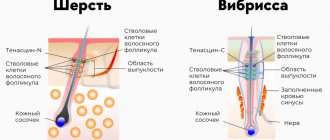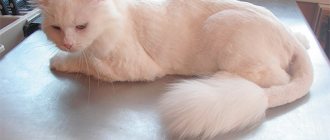Catheterization of the cat's bladder is performed if the pet has difficulty urinating or the urination process stops completely. Such cases are a consequence of kidney failure or the formation of kidney stones. The veterinarian knows how to properly install a urinary catheter and carry out the procedure. After catheterization, the cat needs special care to make the recovery period faster and easier.
When is the procedure performed?
Inserting a urethral catheter for a kitten and an adult is required not only for urolithiasis, but also for other pathological conditions in which the pet does not urinate. Veterinarians prescribe catheterization in case of mechanical damage to the cat’s bladder. Indications for which a urological catheter is required are the following situations:
- Conservative treatment for urolithiasis. This therapeutic technique can be used for pathology once or regularly to facilitate urine excretion.
- Impaired urine flow during acute illness. When abnormalities in the urinary system worsen, the cat is prescribed catheterization for emergency bladder emptying.
- Surgical intervention. After surgery in the area of the urinary system, it is difficult for the pet to walk when necessary, so a catheter is installed. When the muscles are restored, the cat will be able to urinate on its own.
- The need to rinse the cat's urethra and bladder. This measure is carried out during treatment, with its help it is easier to deliver medicines to the affected organs.
- Determination of urination volume and urine collection. Catheterization is performed in a short time, and after the study the catheter is removed.
- For diagnostic purposes. If a cat or kitten needs to take X-rays of the urinary system, then catheterization is performed, through which a contrast agent is injected.
Ascites: what is it and how to treat it
Contents ASCITS
REMOVAL OF ASCITES
FEARS AND MISCONCEPTIONS
There is always fluid present in the abdominal cavity of a healthy person. Normally it is no more than 150 ml. Up to 1.5 liters are produced per day, but it is absorbed and does not accumulate. However, with some diseases, the amount of fluid increases - it begins to be produced in excess, or it stops being absorbed.
Together with surgeon Alina Pribytkova, we understand what ascites is and how it is treated.
ASCITS
What is ascites?
Ascites is an accumulation of free fluid in the abdominal cavity. The reasons may be different: most often it is oncology, chronic heart failure, cirrhosis of the liver or kidney disease.
In oncology, the development of ascites most often provokes metastatic damage to the peritoneum, which causes excess fluid production and/or impairs its reabsorption.
There is another cause of ascites in cirrhosis. Normally, the liver synthesizes proteins that help retain fluid inside the vessel. When the liver is damaged, this function suffers, and fluid leaks through the walls of blood vessels more easily.
In chronic heart failure, blood stagnates in the systemic circulation, increased pressure occurs in the vessels and fluid from them leaks into the abdominal cavity. Also, with this pathology, sodium retention occurs in the body, which also contributes to the development of edema.
Kidney disease causes excessive excretion of proteins in the urine (proteinuria). The loss of protein leads to the fact that the liquid part of the blood is not retained in the vessels and leaks through their walls.
Important Ascites indicates deterioration and progression of the disease. In the early stages of the disease, fluid will not accumulate in the abdominal cavity. This happens only in the later stages of the disease, when the body's ability to compensate has been exhausted.
What types of ascites are there?
Ascites is divided into non-tense and tense.
Small or moderate ascites (non-tense) is a condition when fluid has already accumulated inside the abdominal cavity, but this is not enough to prescribe a procedure for removing ascites: there are no signs of tension, the abdominal wall is soft, pliable during palpation - “pressed”. In this case, surgical evacuation of fluid (laparocentesis) is not used due to the high risk of injuring internal organs, since with non-stressed ascites the distance between the internal organs and the anterior abdominal wall is not enough for manipulation due to the small layer of fluid between them.
With intense ascites, the abdomen becomes greatly enlarged, the skin is tightly stretched, shiny, and the navel may protrude, as during pregnancy. When palpating the anterior abdominal wall, great resistance is felt, which is created due to fluid pressure from the inside.
In quantitative terms, ascites becomes tense when fluid accumulates approximately over 7 liters, but all people are different: physique, parameters, body constitution, size of the abdominal cavity. Therefore, doctors do not focus on the volume of fluid: they perform an ultrasound of the abdominal cavity, examine and palpate the abdomen.
In a person with short stature and asthenic physique, ascites can be tense and with the accumulation of 5 liters of fluid. At the same time, in a tall person with a hypersthenic physique, 10 liters of free fluid may not give signs of tense ascites.
Webinar: Organizing therapeutic nutrition for a seriously ill patient How to organize therapeutic nutrition, what to prepare, what and where to feed, so that the food brings not only benefits, but also pleasure Workshop of CareOlga Kotelnikova
Care
Characteristic symptoms appear with tense ascites: a large belly with a protruding navel, like in pregnant women, a feeling of fullness in the abdomen and pressure on the stomach, nagging pain in the abdomen, shortness of breath, problems with eating due to the pressure of fluid on the stomach - belching, nausea or even vomiting, restriction of physical activity. The accumulation of fluid leads to increased intra-abdominal pressure and pushing of the diaphragm into the chest cavity. As a result, the respiratory movements of the lungs are significantly limited (up to the development of respiratory failure), the activity of the heart is disrupted, and the resistance to blood flow in the abdominal organs increases, the functions of which are also impaired. With long-term ascites, the outflow of lymph from the lower extremities and abdominal organs is disrupted, and swelling of the lower extremities occurs. People note a significant increase in general weakness.
Should we sound the alarm? When?
Ascites does not occur overnight; fluid accumulates gradually. A person may not even notice it and think that he is gaining weight. Usually, suspicions arise when specific symptoms occur: an enlarged abdomen, a feeling of fullness in the abdomen and pressure on the stomach, nagging pain in the abdomen, shortness of breath, belching, nausea or even vomiting, limitation of physical activity, swelling of the lower extremities, general weakness.
If a person notices signs of ascites, you need to see a doctor and do an ultrasound of the abdominal cavity: then the doctor will give recommendations and tell you whether the ascites needs to be removed surgically.
If a person is regularly observed by a doctor, then ascites can be detected during routine instrumental examinations (ultrasound, CT), during examination. If necessary, the doctor will prescribe additional examinations and give recommendations.
REMOVAL OF ASCITES
How is ascites removed?
To treat mild ascites, diuretics can be prescribed, which are most effective in cases of ascites resulting from chronic heart failure or cirrhosis of the liver. However, it should be remembered that there are refractory ascites, that is, resistant to diuretic therapy, when the use of medications does not have a positive effect. With prolonged, uncontrolled use of diuretics, the patient develops water and electrolyte disturbances, dehydration, and a drop in blood pressure. With ascites of an oncological nature, diuretics are most often ineffective.
For tense ascites, doctors perform laparocentesis: under local anesthesia, a puncture of the anterior abdominal wall is performed and the fluid is evacuated.
The frequency of the procedure depends on how quickly the fluid accumulates, on the existing pathology and the degree of its progression. For some, tense ascites may recur within a few months, for others within a week/month.
For ascites, the cause of which is chronic heart failure or cirrhosis of the liver, diuretics are also prescribed after surgical removal of the fluid, if the person’s condition allows.
How is the procedure done?
If there is a clinical picture of tense ascites, an ultrasound of the abdominal cavity is performed to assess the level of free fluid and determine the safest point for puncture of the anterior abdominal wall.
They talk with the person: they explain to him the principle of the planned manipulation, the possible risks, as with any invasive intervention. After which, if he agrees to the manipulation, the person signs an informed consent to the intervention. If a person is legally capable, he must sign the document himself; if not, then this is done by his official representative.
The area of the planned puncture of the anterior abdominal wall is treated with an antiseptic solution and then anesthetized layer by layer with a 5-10 ml syringe with a local anesthetic solution (lidocaine, novocaine - if the patient is allergic to these drugs, tell the doctor!). At the same time, the location of the needle is monitored - when it enters the abdominal cavity, ascitic fluid appears in the syringe.
Then, using a long hollow needle - or a special instrument - a stylet with a trocar, depending on the equipment chosen for the manipulation - the doctor pierces the anterior abdominal wall at a previously designated point and penetrates the abdominal cavity, receiving a flow of fluid through the needle. A plastic catheter is passed through the needle into the abdominal cavity, and the needle itself is removed. The plastic catheter is sutured to the skin to prevent it from moving or falling out. Through the catheter, the outflow of fluid goes into a vacuum bag attached to it (for better outflow, the bag should be below the level of the bed - on the floor or attached to the side of the bed).
The most favorable is fractional removal of fluid - 3-4 liters per day, as this will help avoid a sharp drop in pressure inside the abdominal cavity.
Skin care products for a sick person: how to choose? We help you understand the variety of foams, dry shampoos, creams and lotions for hygiene, including in special cases - with bedsores, an established stoma, urinary and fecal incontinence Evgeniya RezvanCar Care Workshop
Care
The drainage is in the abdominal cavity for several days, since it is fixed to the skin with a suture - you can turn, eat, move, the tube will not go anywhere. The puncture site must be treated with an antiseptic once a day and covered with an aseptic bandage. Usually, drainage does not cause pain; on the first evening after the puncture, there may be a slight pain in the area of the puncture of the abdominal wall, then, if there is no planned pain therapy, you can take a painkiller from the NSAID group (if there are no contraindications). But the drainage tube can touch the peritoneum, which lines the anterior abdominal wall from the inside and internal organs, and this in turn can cause discomfort.
After removing the ascites, the drainage from the abdominal cavity is removed. A suture may be placed over the punctured area to prevent any remaining fluid from leaking out. It is impossible to remove everything “dry”, since residual fluid remains in the pelvic cavity and between the intestinal loops, and its accumulation does not stop after laparocentesis. If a suture was not applied, then after a while the tissues “stick together” and the liquid stops leaking.
If a suture was placed after removing the drainage, then it must be treated with an antiseptic solution, the dressings should be changed once a day, healing usually occurs in 7-10 days. If a suture was not applied, the principle of care is the same, the difference is that in the first day or two after removal of the drainage, there may be a need to change the dressing more often due to slight leakage of fluid.
There are ascites that are difficult to evacuate: the liquid may have a gel-like nature, a heterogeneous structure, which can clog the drainage, or in rare cases, the liquid may not flow through the drainage at all due to its excessive viscosity. If the drain is blocked, the doctor will flush it with sterile saline to restore drainage.
Patient N., 56 years old. Diagnosis: Ovarian cancer, disease progression, peritoneal carcinomatosis, tense ascites. According to ultrasound, ascites is gel-like in nature, with a volume of about 10 liters. A decision was made to perform laparocentesis. As a result of the manipulation, practically no liquid flows through the installed plastic catheter due to an excessively thick jelly-like consistency that cannot be actively aspirated (that is, removed by attaching a syringe to the catheter). Next, a repeat laparocentesis was performed using a large-diameter trocar (hollow metal tube), with which it was possible to evacuate no more than 3 liters of secretion. The patient was recommended symptomatic therapy; further attempts to evacuate secretions are inappropriate due to the risk of complications.
The laparocentesis procedure is not very long, in typical cases it takes no more than 15-20 minutes. There are technically complex cases that require more time: if a person has excessively developed subcutaneous fat, there have been surgeries on the abdominal organs in the past, massive growth of metastases in the peritoneum, the presence of voluminous tumors in the abdominal cavity. In such cases, puncture can be performed directly under ultrasound guidance.
Is it possible to carry out the procedure at home? Can I go home immediately after the procedure?
Removal of ascites is a surgical intervention; it is not performed at home, like any other surgical operation: there is no necessary equipment, conditions, and sterility cannot be ensured.
It will also not be possible to go home with drainage, since it is a foreign body. It must be removed at a medical facility. At home, if the drainage is handled incorrectly, it can become dislodged/fall out, which can lead to infection. It is not recommended to remove ascites “in one day”; it is better to do it gradually, over several days, since the immediate removal of a large amount of fluid can provoke a sharp drop in pressure inside the abdominal cavity, which will entail a drop in a person’s systemic blood pressure and a deterioration in general well-being.
Are there any contraindications to the procedure? When can doctors refuse to perform a procedure?
The procedure is not performed when the ascites is not tense or is not tense enough, since in these cases internal organs can be damaged. With mild ascites, there are no painful symptoms, which is the reason to perform laparocentesis. It must be remembered that evacuation of fluid does not cure the disease, but only alleviates the painful manifestations that arise when there is a large accumulation of fluid.
Evacuation of fluid is not carried out if a person is in extremely serious condition, in other words, when the life prognosis is calculated in hours or days, and this means a complete depletion of the body’s compensatory forces. And the loss of protein, electrolytes, a decrease in intra-abdominal pressure with general hypotension (which is always present in the last days and hours of life) can only worsen the patient’s condition; after the manipulation he may not experience relief, and the stress of the intervention will add additional painful sensations to the already extremely serious condition. And we remember that the manipulation is invasive in nature, that is, like any surgical intervention, it can have a number of complications.
The procedure may be refused when a critical accumulation of fluid coincides with the transition to the terminal stage of the disease. Of course, the fluid can be evacuated: technically this is possible for almost any patient's condition, but the person's general condition will continue to get worse as the underlying disease progresses, and the fluid, even during the evacuation process, can quickly accumulate again. As mentioned above, it must be remembered that laparocentesis does not cure the disease, but only alleviates the painful manifestations that occur with a large accumulation of fluid, and it is necessary to compare the expected benefits of the manipulation and the existing risks of causing additional discomfort to the person at the end of life.
For example, according to abdominal ultrasound, the volume of ascites is 8 liters. The doctor puts in a drainage, but the fluid accumulates every day. A person gets 8 liters, 10 liters, 12 liters removed - so a week passes, and the drainage is still standing. He does not experience relief from the manipulation, and the drainage located in the abdominal cavity causes discomfort and complicates the care of the patient.
We already know that when ascitic fluid is removed, a person loses valuable substances - proteins and electrolytes. The protein concentration in serous ascitic fluid is usually relatively low, but with massive ascites, its total loss can be significant, especially with frequent repeated removal of large amounts of fluid, and the loss of protein is combined with the loss of salts, which leads to the development of severe protein and electrolyte deficiency.
Frequent laparocentesis or fractional pumping of fluid from the abdominal cavity over a long period of time will do more harm than good, so transition to the terminal stage of the disease is a contraindication to the procedure.
When it cannot be cured: 7 questions about palliative care Why palliative care is needed, whether it is necessary to register and what to do if a person or his relatives insist on continuing treatment Editorial Board "Vera" Foundation
About palliative care
Laparocentesis is not performed if:
- blood clotting is impaired (the risk of bleeding increases);
- decreased platelet levels (especially after chemotherapy);
- a pronounced adhesive process has been diagnosed (dense connective tissue (cords, adhesions) is formed in the abdominal cavity after inflammatory processes, injuries or surgical interventions, which “solder” the internal organs in the peritoneum, lining the anterior abdominal wall from the inside) - this is a risk of injury to the internal organs;
- peritoneal carcinomatosis was diagnosed, when the abdominal cavity is so affected by metastases that a safe area for puncture is not visualized, which is also fraught with injury or bleeding;
- a person has an unfavorable life prognosis (days, hours).
FEARS AND MISCONCEPTIONS
Is it possible to die from ascites or from the procedure for its removal?
Ascites, like the procedure for removing fluid from the abdominal cavity, cannot cause death. Ascites is not an independent disease, but usually acts as a symptom of one or another serious disorder in the body.
It should be remembered that with laparocentesis, as with any surgical intervention, even in the absence of contraindications, there is a low risk of complications.
Can ascites occur due to medications? Chemotherapy?
Drugs and chemotherapy cannot cause ascites.
Important: People with ascites are advised to evacuate it before chemotherapy to increase effectiveness.
To prevent fluid from accumulating, should you drink less water?
It is necessary to maintain a water-drinking regime, drink as needed. Refusal to drink can worsen the general condition and provoke the appearance of additional painful symptoms against the background of dehydration.
What happens if ascites is not removed?
Fluid in tense ascites does not mechanically damage internal organs, but can put pressure on the stomach, intestines, diaphragm, lymphatic system and disrupt their functions. This can cause breathing problems, constipation, nausea, vomiting, hiccups, belching, heartburn, loss of appetite, swelling of the lower extremities, even lymphorrhea (“sweating” of fluid through the skin). Against the background of the underlying disease, pain may intensify, and a feeling of tension and fullness in the abdominal cavity may appear.
It happens that with a very large accumulation of fluid in the abdominal cavity (20 liters or more), the pressure on the tissue is so high that the fluid begins to find “weak spots” in the abdominal wall and seep through them (scars after operations and even the navel).
Can internal organs be damaged during the procedure?
With mild ascites, there is a high probability of damaging internal organs, so in this case laparocentesis is contraindicated. If there is a significant amount of fluid and signs of tension, the risk of injury is minimal. Complications are possible with any operation, but with the correct indications and taking into account all contraindications, in the vast majority of cases laparocentesis occurs without complications or injuries.
Can drainage damage internal organs?
Changing the position and turning a bedridden patient Care specialist Olga Vygovskaya shows how to correctly turn a bedridden patient Olga Vygovskaya
Care
The drainage tube is soft, it will not damage the internal organs, but it can touch the peritoneum lining the anterior abdominal wall from the inside and internal organs, and this in turn can cause discomfort.
Is it possible to lie on your stomach with ascites? Is the blow dangerous?
Lying on the stomach for a person with tense ascites is extremely uncomfortable, but this is not prohibited. Most often, a person takes a position on his side. Any blows to the stomach in everyday life are also not dangerous: it is a liquid, it “flows around” the internal organs. Blows of excessive force are equally dangerous for internal organs, regardless of the presence of fluid in the abdominal cavity.
Are emergency operations performed for ascites?
If, for urgent reasons, a person with ascites suddenly finds himself on the operating table, this is not a contraindication to emergency surgery; surgeons simultaneously remove free fluid; all operating rooms are equipped with electric aspirators.
The material was prepared using a grant from the President of the Russian Federation provided by the Presidential Grants Foundation.
We would like to thank the volunteers of the Vera Hospice Fund for their assistance in preparing the material.
Stock image used from Depositphotos.
Preparatory stage
The animal may require general anesthesia as the procedure is quite painful.
If the cat’s urine is no longer excreted normally, then it is necessary to use a catheter. Catheterization in kittens and adults can be performed once, and if a one-time procedure does not help, then repeated manipulation is performed. The catheter is installed not at home, but in a veterinary clinic. First, the specialist conducts an examination and finds out whether the cat needs to undergo the procedure. Before catheterization, the following preparatory steps must be completed:
- Carrying out pain relief measures. When such urological manipulations are performed, the cat may feel severe pain. To eliminate the unpleasant symptom, general or local anesthesia is used. The first type of pain relief is required for pets in satisfactory condition, the second - in case of chronic disease.
- Genital hygiene. Before inserting a catheter into the cat's urethra, hygiene procedures are carried out. The specialist shaves the hair in the area of the penis and around the genitals. The skin is disinfected using antiseptics, which will prevent the entry of pathogenic microorganisms.
Since there are many nerve endings on the head of the pet’s penis, local anesthesia using drugs in the form of aerosols is equally important during catheterization.
Bladder catheterization in a cat: consequences
After this treatment procedure, your pet may experience various complications, which include:
- Lack of diuresis. Due to the fact that the urethral muscles are in spasm, the pet cannot go to the toilet. To eliminate the pathology and relieve unpleasant symptoms, the animal is prescribed antispasmodics.
- Urethral injuries. Can occur if the specialist is inexperienced. In such a situation, the cat must be taken to the veterinarian again. The injuries are characterized by severe pain in the urethral area, the cat licks the sore spot and cannot urinate normally. Sometimes there may be blood in the urine.
- The cat often licks itself after bladder catheterization. This may be due to unpleasant sensations after the procedure, which will accompany the pet for some time, or due to the presence of injuries.
How is a cat catheter placed?
The doctor must insert the device very carefully so as not to further injure the urinary tract.
Only a veterinarian can correctly place a tube to drain urine and carry out the necessary manipulation. The technique requires special care, since during the procedure there is a high risk of mechanical damage, which will lead to serious complications. A catheter equipped with a mandrel is inserted into the animal's urethra. Before insertion, the tube is lubricated with a lubricant so that it can be inserted further and the walls of the organ are not damaged. If the catheter does not pass through during manipulation, then special solutions are injected into it to remove any blockages that have arisen. When urine comes out of the tube, this indicates that it has entered the bladder. During the procedure, a small amount of material is taken for laboratory testing. If urine is released with blood, damage to the walls of the organ is detected.
Long-term catheterization of the bladder in cats is often carried out, during which the catheter must remain in place for 2 days or more. In this case, the specialist stitches the tube to the red flesh. Thus, urine is removed from the bladder and collected in a special tank. With such a pathology, the cat needs to follow a diet and take medications. With the help of veterinary medications, it is possible to alleviate the symptoms that occur during catheterization.
What is a Foley catheter and when should it be installed?
One of the most common devices for urination is a Foley catheter. This device is effectively used in the following cases:
- diagnosis of diseases;
- stimulation of labor;
- preoperative manipulations;
- urinary retention.
The effectiveness for urinary problems lies in the fact that after connection, urine begins to flow into the collection bag immediately after installing the device. Installation of a Foley catheter is very often prescribed for those patients who will use the device for a long period of time.
Based on the materials used, Foley catheters are divided into 2 types: silicone and latex. They also produce silicone catheters coated with silver to prevent infections. According to their design, Foley catheters are available in 2-way and 3-way types. In the first option, there are channels for draining urine and filling the balloon. The 3-way has an additional channel to administer drugs and is considered more popular among patients.
Additionally, Foley catheters are divided into the following types:
- Male. Its length reaches 40 cm, since the urethra is much longer than in women.
- The female model of the Foley catheter measures 26 cm. This is due to the much shorter length of the channel.
- The children's device comes with a stylet for insertion into the child's urethra, measuring 28 cm.
How to choose the right Foley catheter
To choose the right Foley catheter for a patient, you should first listen to the recommendations of your doctor. It is also necessary to consider the amount of time for which the device will be needed. The main factors for choosing a Foley catheter are:
- device size;
- person's age;
- catheter purpose.
Only the attending physician can correctly determine the type of catheter. If you select it yourself, you may make mistakes in calculating the size, and the device will not fit.
Necessary care
Sterile gloves are required to replace the device yourself.
If catheterization is carried out frequently and for a long time, then the owners should know how to care for the cat during this period. It is important to use antibacterial drugs to prevent pathogenic microflora from entering the urinary organs. If you need to replace a catheter at home, you must strictly follow the rules of hygiene and carry out the manipulation using sterile gloves. If the tube becomes very dirty, it is recommended to rinse it under running warm water.
The danger of the procedure: what is it?
If you do not follow all medical recommendations during catheterization and during further care of the cat, then unpleasant consequences are possible. Often after the procedure, mechanical damage to the urethra occurs, against the background of which an inflammatory reaction is recorded. Catheterization may also be complicated by lack of urination. To eliminate the problem, you will need to take antispasmodics. If the procedure is performed by an experienced veterinarian, then no complications will arise and the procedure will bring a positive result and the cat will no longer have difficulty eliminating urine.
Indications for catheterization
Inflammation of the kidneys and intestines are the main indications for catheterization. A blocked bladder increases potassium levels (hyperkalemia), which affects the heartbeat and can lead to the death of your pet. Once a urinary obstruction is identified, emergency treatment and stabilization are required.
Catheterization is performed for:
- Diagnosis of urolithiasis.
- One-time urine collection for analysis if excretion through cystocentesis is not possible.
- Inclusions of contrast agent during examinations.
- Obstruction therapy.
If your cat has chronic kidney disease, the urethra may need to be dilated. This procedure is designed to provide a permanent opening that allows crystals, mucus plugs, or small stones to pass out of the urethra.
In most cases, a dose of general or local anesthesia is administered before the procedure. Infection of the renal pelvis, kidney stones, and chronic renal failure are possible consequences of recurrent urethral obstruction.











